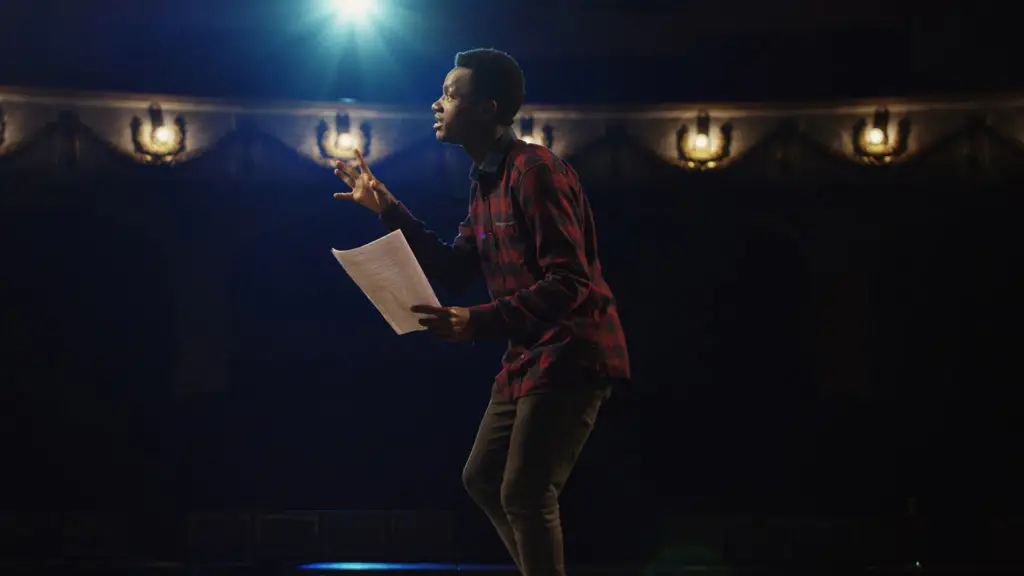From the ancient Greeks to modern-day theater, drama has persisted as a powerful means of storytelling and human expression. Drama techniques are the lifeblood of any engaging theatrical performance.
Learning to master different strategies can transform an ordinary script or play into a captivating experience for the actors and the audience.
We’ll explore different drama techniques and share lessons guaranteed to elevate your acting game. We’ll also examine time-tested styles used for developing characters, honing improvisation skills, and crafting compelling scenes.
No matter your level of experience, these methods promise exciting opportunities for growth, inspiration, and discovery. Settle in and prepare to unlock the wonders of the dramatic arts as we venture into a realm where the only limits are your imagination and the power of your performance.
Setting the Stage: Understanding the Types of Creative Drama Techniques
Understanding various drama techniques is crucial for an actor to develop their unique approach to acting. With countless ways to explore and use drama techniques, finding the ideal technique for an individual can be a rewarding journey.
Here are the top methods that actors usually explore:
Improvisation and Spontaneity
Improvisation, or improv, involves performers creating scenes and dialogues spontaneously without a script. This technique challenges students in their ability to be present in the moment, react authentically, and develop their creativity and quick thinking.
Physical Theater
Physical theatre focuses on using the body as a primary narration tool. By emphasizing movement, gesture, and non-verbal communication, performers can express feelings and narratives in a compelling way.
Method
The Method involves deeply immersing oneself in a character by tapping into personal experiences and emotions. Actors stay in character throughout the entire production process to achieve a realistic and intense performance.
Classical
Classical drama is based on traditional techniques that focus on text interpretation and stylized, controlled delivery. Performers concentrate on vocal projection, volume, pitch, diction, and precise physicality, aiming for a polished and elegant performance.
With various techniques available, actors should consider their strengths, interests, and goals. Experimenting with different methods and training can help reveal the ideal fit, allowing for personal growth and captivating performances.
Embodying Your Character: The Power of Body Language and Mannerisms
In acting, voice, movement, and mannerisms play a crucial role in bringing a character to life on stage. In this section, we’ll discuss the importance of non-verbal communication in drama and share expert tips for mastering body language in your performances.
Non-verbal communication, such as gestures and facial expressions, conveys a wealth of information to the audience. From conveying emotions to setting the tone of a scene, an actor’s physicality, and facial expression can say much more than words.
To develop a solid foundation in gestures and mannerisms, consider implementing the following tips:
- Observing and mimicking real-life mannerisms: One technique actors can utilize is learning from the people around them. Observe everyday interactions and take note of distinctive gestures or movements that could be incorporated into your character.
- Using mirrors to refine your expressions and movements: Improve your body language skills by regularly practicing in front of a mirror—this role play allows for self-evaluation and fine-tuning of your physical performance.
- Experimenting with different postures and genres: To create a fully-rounded character, try incorporating a range of postures and gestures to communicate your feelings, thoughts, and intentions.

Ultimately, an actor’s ability to embody their character through realistic facial expressions, authentic gestures, and mannerisms is what captivates an audience. Commit to your character’s physicality, and your performance will be believable and engaging.
Personal Space: Exploring the Dynamics of Proximity in Acting
Space plays a crucial role in drama, significantly impacting the overall story and relationships between other characters. In this section, we’ll dive into its importance, how to navigate it, and practical techniques for performers to achieve desired results on stage.
Personal space is more than merely physical distance; it’s a vital tool for conveying emotions, relationships, and power dynamics. Performers must be aware of their character’s space and that of other characters, recognizing that these spaces can also change depending on various situations throughout the performance.
One of the keys to mastering space in drama is practicing scenarios that require different levels of proximity. Being sensitive to other actors’ gestures and subtle cues can help you adjust the pace of your movements accordingly.
And remember, it’s not only about moving closer or farther away from someone but also knowing how to use angles, levels, and other spatial elements to enrich the scene.
Creating Intimacy and Tension
Manipulating space can strengthen emotional connections or create tension between characters. For example, leaning in during a conversation with any other actor portrays intimacy—simultaneously conveying vulnerability.
Conversely, lingering close to another character when it’s uncomfortable for them can create intense dramatic tension.
Conveying Power Dynamics and Relationships
The use of personal space can signify power dynamics between characters. For example, a character maintaining a close distance while speaking authoritatively to another character might indicate dominance. Likewise, shifting one’s space to match the other character’s movements can demonstrate a struggle for control or partnership.
Establishing Boundaries for Your Character
Just as people have space boundaries in real life, characters in drama should also have boundaries that help define who they are. By determining and respecting these boundaries, actors can create believable, multi-layered performances that effectively engage their audience.
Crafting a Fictional World: The Art of Immersion and Believability
Creating a compelling and immersive fantasy is a crucial skill for actors and playwrights. It involves developing authentic characters, crafting engaging narratives, and skillfully using visual, auditory, and emotional cues to draw the audience in.
To transport the audience into the character’s universe, an actor must fully embody the persona and convey a sense of realism. They should connect emotionally with the character and draw upon personal experiences to bring the role to life.
The key to building a captivating and convincing fictional sphere lies in mastering a few essential techniques highlighted below:
1. Visualizing and Internalizing Your Character’s Environment
Actors must visualize the world they inhabit and internalize it. This process involves researching the setting, understanding its history, and considering how it impacts the character’s psyche.

2. Developing Rich Backstory and Context
A rich backstory adds depth to the characters and their relationships. Performers should consider the character’s past experiences, social status, and critical events that shaped them.
3. Engaging the Audience Through Narration
Effective narration engages the audience on an emotional level. Actors can achieve this by utilizing vocal variety, pacing, and motion to convey the character’s emotions, motivation, and journey.
Conclusion
Drama techniques play a significant role in shaping an actor’s performance. With a thorough understanding of these methods, performers can unlock their full potential on stage. Here’s a recap of the key points from this article:
- Character development is essential for believable performances.
- Body language and vocal techniques enhance emotions and storytelling.
- The use of improvisation encourages creativity and adaptability.
- Understanding space and staging brings depth to performances.
As an actor continues to apply new drama techniques, their skill and confidence grow. Learn different styles to develop a unique approach to your craft and captivate audiences—this can be rewarding, fun, and fulfilling.
Frequently Asked Questions
How Do I Choose the Right Drama Technique for Me?
Consider your strengths, weaknesses, and personal preferences when exploring various drama techniques. Assess the goals and the style of the performance.
A mix of research and experimentation will help you select the technique that best complements an individual’s unique talents and goals.
Can I Combine Multiple Drama Techniques in My Performance?
Integrating multiple drama techniques can enrich a performance—this fusion of methods offers versatility and opportunities for creative self-expression. However, be cautious—combining too many techniques can cause confusion and undermine the overall impact of the performance.
How Can I Improve My Body Language and Mannerisms in Acting?
Begin by observing people around, taking note of their posture, sound, gestures, and expressions. Practice exaggerating these behaviors in front of a mirror or with a recording device. Cultivate mindfulness, focus your energy on self-awareness, and employ targeted exercises to improve specific aspects of body movement.
What Are Some Exercises to Practice Personal Space Awareness on Stage?
Here are a few exercises to try:
- Distance duets: Perform scenes with a partner, experimenting with different levels of closeness.
- Group mirroring: Mimic the movements of a group leader, paying attention to the space shared with others.
- Stage walk: Navigate around the stage, maintaining an equal distance from other actors and stage elements.
How Can I Make My Fictional World More Engaging and Believable?
Creating a captivating fantasy involves several key factors:
- Develop well-rounded characters with unique histories, motivations, and conflicts.
- Construct settings rich in detail and purpose, able to transport the audience.
- Embed a story that elicits an emotional response and fosters a personal connection.








